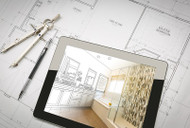
The bathroom may be the smallest room in most houses, but an update to this little space can have a big impact on your home’s look. Don’t let size fool you though; a bathroom renovation is no small job. The materials involved and the complexities of plumbing, electrical work and waterproofing mean that this is an advanced project requiring significant time, money and skill. We’ve gathered some tips to help you learn how to remodel the bathroom yourself — or work with a contractor to complete the process without headaches.
How to Remodel a Bathroom
Research
Before you pick out tile and start pulling down fixtures, gather inspiration and decide on the look you want. You also need to determine your budget, and decide whether you’ll be remodeling yourself, or hiring a professional for some or all of the work. Ask yourself: What is your time frame for the project? What skills do you have? How much time can you devote to the renovation? What tasks will you need help with throughout the project?
If you’re not sure how to remodel a bathroom, you can look online for video tutorials or instructions for each part of the project, to make sure you understand every step of the process. It’s also a good idea to research the building codes and permits you’ll need, if any. You don’t want to get knee-deep into a renovation, only to run up against limitations that could cost you time and money.
Be careful not to overestimate your skill level, or under-estimate the amount of time the remodel will take. The last thing you want is to be left with an unfinished or poorly constructed bathroom; it’s one of the most important rooms in your home!
Design
After your research, you can either hire a contractor or start making decisions yourself about the type and amount of materials you will need. What about the walls? Will you tile them? Use wainscoting or paneling? Wallpaper? There are a myriad of options to choose from for your project. What aesthetic do you want to achieve? Which colors, textures and styles do you want to incorporate? Spend some time thinking about these elements. But don’t buy just yet.
Consider faux bathroom wall panels as an alternative to more traditional materials. As long as the panels are not installed directly in the shower or bathtub, these panels can provide the maintenance-free, authentic appearance of tile, brick, stone or wood that looks great for years to come. Best of all, they’re quick and easy to install and more affordable than the real thing.
You also need to take measurements of your space (more than once!) to make sure that you buy the right amount of materials. Be sure that your new toilet will fit, that your shower stall is the right size, that the tub will fit in the space allotted — the list goes on and on. When planning your design, carefully plot out where everything will go, from plumbing connections to electricity sources. Don’t forget about storage spaces; do you want to increase or decrease these areas?
You also need to gather the necessary tools if you’ll be doing it yourself. You don’t want to be caught without an important item in the middle of renovations. Lining up the right tools and materials can take time. Don’t start tearing up your bathroom until all the parts and materials are on hand.
Consider the easy-to-forget factors too. How will you dispose of old items? How will you light the space while you’re working? (You’ll have to turn off power and water during renovations, so communicate your plans with the other members of your household as well.)
Demolition
For some of us, demolition is the fun part of a renovation, but don’t rush it. Before you start swinging your sledgehammer, make sure water is turned off to all elements in the bathroom. Carefully remove your toilet (draining it first), tub and sinks. Turn off the electricity before removing lighting fixtures. Remove towel racks, hooks and other accessories. Plug the toilet plumbing, and make sure to avoid damaging plumbing and electrical work while you are gutting your bathroom. When that’s all done, you can grab your chisel and mallet, and carefully chip away at your old bathroom features. Make sure you’re wearing protective equipment, and don’t use a sledgehammer on insulation.
As you remove tile, flooring, cabinetry, toilets, tubs, etc., look for water damage, mold and other issues that may need repair or mold remediation before you cover those spots back up. You might want to carefully remove baseboards so you can reinstall them when you’re finished.
Plumbing
Once your bathroom is down to its bare bones, the next step is installing your new plumbing elements. These can include a shower pan, a tub, different shower controls or changes needed to the plumbing, such as plumbing for double sinks.
Electrical
Before installing any new drywall, tile or paneling, determine whether you want to make changes to your electrical system. Do you need to update your wiring, to better handle hair appliances, for example? How about adding or relocating outlets? Do you want to install a vent? This is the stage for making these decisions.
Reinforcement
If you’re considering adding grab bars in the bathroom, you need to reinforce those areas of the wall with blocking before you add the tile to your walls, shower stall or tub area.
Walls
Prepare your shower stall and tub areas with cement board walls and a vapor barrier to reduce the effects of humidity. Areas outside the tub and shower can be drywalled if you choose. With that complete, you can paint your walls. You’ll probably want to choose a satin or semi-gloss finish to resist the dampness inherent to bathroom spaces.
Shower and Tub Installation
Bring in your shower pan and tub at this point and install them in the right locations. Carefully hook up the plumbing before covering up with tile.
Tile Installation
If you’re using tile, now’s the time to install it. Start with the shower or tub areas, beginning with the walls. Your flooring should be the last step. Don’t forget to caulk around corners and grout between tiles.
Other Features
With the basics in place, you’ll install your shower door, light fixtures, fans, vanities, sinks, towel racks or hooks, mirrors and light-switch plates. Your toilet should be one of the last items you add to avoid damaging it while you are working.
Enjoy!
You’ve worked from the studs to the final touches. Now you can relax in a bath and enjoy the updated look of your new space.
Shop Related Products


